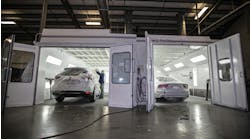Not many collision repair topics raise more ire more quickly than flat rate. Is it a positive force for financial incentives and production efficiency or a negative force that encourages technician short cuts and customer confusion?
As one of the basic estimating principles, let's explore what it is, where it came from, how it is developed and who benefits from it. Let's start with this definition from www.motorera.com:
Flat rate is a pre-determined length of time set down by the manufacturer that a particular repair job will take and is listed in the flat rate manual. If the flat rate is two hours, but the mechanic completes the job in more or less time, you will be charged for two hours. For the shop, flat rate encourages mechanics to work harder to beat the prescribed time, thus earning more for the shop and the mechanic. But it also hurts the shop when the mechanic cannot complete the job because of other contributing factors (i.e., a bolt that should have taken 10 seconds to remove breaks off and requires 30 minutes to remove). For the customer, flat rate means fair pricing for the same job no matter how long it actually took. Thus both Sam's labor bill and my labor bill to do the same work is the same cost. It can be unfair if the mechanic worked faster on my vehicle (because I keep it in excellent shape) than on Sam's vehicle (because his involved a lot more cleaning, etc. to do the job). Also, there is the danger that a mechanic may take shortcuts in order to beat the flat rate, which may cause mechanical problems later. Charging by the actual time the mechanic takes is called straight time.
Flat rate manual is a listing of almost every job that can be done on a vehicle with the time required for a mechanic to do the work. It is used in service shops to determine labor charges. If a mechanic completes the job before the flat rate time, the customer is still charged the flat rate time. If he exceeds the flat rate time, the customer is not charged for straight time, but the lower flat rate time.
So a flat rate system generally tries to provide predictable costs for a vehicle owner and financial incentives for a technician. However, there are some inherent flaws, opening the door for abuse. How did this all start?
In the early years of automotive history, development of various vehicle systems was fast, crude, and a bit frightening. Some had only three wheels, some steered with a rudder and some were steam powered. With hundreds of small vehicle manufacturers building cars by hand and constantly experimenting, each was unique. Breakdowns were frequent and maintenance was required often. Carburetors, cylinder heads and engine bearings needed attention — usually overhauls — every few months. Flat tires were common — mostly from loose horseshoe nails in the existing "roads." Leather brake pads wore out fast. Each owner was his own mechanic, or was wealthy enough to employ one.
That all changed during the 1920s as Henry Ford improved the assembly line. Production models became consistent and interchangeable parts became normal. With reduced costs, car ownership became within reach of regular working adults. As cars and trucks became widely available and more reliable, vehicle owners didn't need to know the mechanical workings of their new machines anymore. However, they still needed repairs and maintenance, so the automotive service profession — and collision repair — developed.
The roaring twenties ended with a stock market collapse in October 1929 and resulted in depression conditions throughout the 1930s. As some older technicians remembered, there was little money and work available. Auto dealers and repair shops were reluctant to hire technicians and commit to a guaranteed paycheck. Instead, they worked out an almost freelance arrangement and split the labor charges collected, usually 50/50, when there was work.
Charging straight time seemed to make sense, until competition came into play. If mechanic A across town could replace a water pump faster than mechanic B, they would be charging less for the same job. Customers naturally would migrate toward the greater value for their money. There had to be a way to provide consistent prices for the owner and leave profit margins up to the efficiency of each shop. The idea of a "flat rate" was born.
"Money is better than poverty, if only for financial reasons." — Woody Allen
Bruce Burrow, AAM started writing estimates over 30 years ago, has worked for most of the information providers, and, as an independent instructor for the last 10 years, has trained estimators all across North America. He is ASE Master certified and an instructor for the Automotive Management Institute. Send questions, ideas, and comments that you would like to see addressed here to [email protected] and stay tuned.



